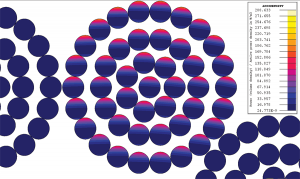Electromagnetic Losses Modeling in a High Power, High Frequency Permanent Magnet Machine Considering Power Electronics Drive Switching Harmonics
Xiaolong Zhang with adviser K. Haran
Electric propulsion has been proposed for large commercial aircraft to reduce fuel use and/or emissions, potentially achieving significant environmental and economic benefits. A high-power, high-frequency permanent magnet synchronous machine (PMSM) drive system is being developed to meet the stringent weight requirements in the aircraft application. The machine employs a multiple-pole, “iron-less” topology for a very high specific power. It will be driven by a switched-mode power electronics converter. Rich harmonic content is present in the machine excitation currents due to low synchronous inductance and the pulse width modulation (PWM) process, which incur additional electromagnetic losses. These harmonics and additional losses need to be accurately modelled to facilitate an optimal system design for minimal weight and high efficiency.
The modeling is comprised of three steps. First, the voltage PWM harmonics spectrums are analytically determined using the double Fourier integral analysis method. Second, a high-fidelity motor equivalent circuit model is used to determine the current harmonics with the voltage spectrums as inputs. Figure 1 shows good agreement between the current waveforms reconstructed from the analytical spectral analysis and those from the numerical simulation.

Figure 5: Machine phase current waveforms from the analytical spectral analysis and numerical simulation
Finally, the waveforms are imported to the PMSM finite element (FE) model to calculate copper, iron and magnet losses. Figure 2 shows the FE harmonics losses densities in the machine copper conductors. This method can accurately determine the magnitudes of various loss components, which also helps thermal management design of the machine. Next step, we will conduct a high-power drive test and verify the losses modeling with experimental data. This research is supported by the Grainger CEME and ARPA-E.
